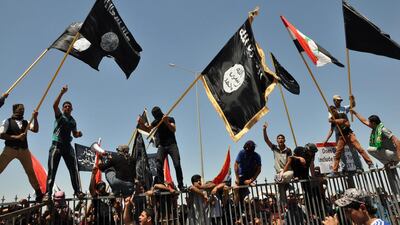An ISIL video that circulated a few weeks ago offered an insight to the outfit’s next phase.
In a desert clearing, a fighter gave a tutorial to recruits on how to bake bread with only sticks, stones and elements available on the ground.
After its purge from Mosul and with the collapse of ISIL positions in Raqqa all but complete, the nature of the beast is changing.
ISIL is often seen as an urban and a viral force. Images smuggled from Raqqa markets in the earliest days after its takeover of the town sealed an idea of the group. Amid the atrocities in Mosul, the stories of ordinary residents using their homes as sanctuaries created a powerful narrative.
What has been less clear is that ISIL is a phenomenon of the desert and land between two rivers, the Tigris and the Euphrates. The battle focus has now shifted to that terrain and with it, a new factor has emerged.
The ground fight against ISIL is also a fight against Iran's attempt to open a land corridor to the Mediterranean. David Petraeus, the former CIA chief, central command head and leader of the Iraqi surge, pinpointed how the two battles have now morphed, at a conference organised by United Against a Nuclear Iran this week.
____________________
Read more on ISIL
New document sheds light on the changing nature of ISIL's combat tactics
UN approves special team to investigate ISIL crimes in Iraq
Isil has created a long lasting appeal among angry young Muslims, debate hears
____________________
With the mind's eye of a retired commander, Mr Petraeus sketched out a challenge to Iraq’s security force as it secures control of two key points on each river. At stake is Iran’s long-held ambition to have an uninterrupted axis not just by air, but by land from Tehran to Tartus.
ISIL may have been driven out of Mosul and Tel Afar, but it retains its grip on Hawija, the stronghold of Saddam Hussein on the Tigris. An offensive against the town was launched last week. Battlefield reports are already declaring progress with the fall of the hamlet of Ana.
How these gains are made is crucially important. The Shiite Popular Mobilisation Units (PMUs) are heavily involved in the offensive and have seized towns like Shirqat.
On the sidelines of the UN General Assembly gathering, Mr Petraeus voiced his concern about how this plays out. These towns are key nodes on what the US military knows as the rat-runs of the Tigris. Numerous roads and tracks cross the verdant plains and run east to Baqubah, from where routes to the Iranian border are opened up.
With the PMUs entrenched for the first time south of Mosul and across to Tel Afar on the Syrian border, Hawjia is the last piece in the puzzle. Placing it under the pro-Iranian militia opens up a swathe of free passage.
A comparable opening sits on the Euphrates. Control of the cross-border towns of Al Qaim and Albu Kamal is the ultimate prize in the fight for the Euphrates River Valley. A sweep south from Raqqa and Deir Ezzor represents a race between Iran-backed Syrian regime forces troops and the US-trained opposition forces.
The ISIL video instructing its followers in the art of making bread in the desert is an indication the group is likely to scatter as a rearguard action plays out across a wide area.
On the Iraqi side, Al Qaim is strategic town that has switched sides in numerable times in the past 15 years. It boasts a railway head that dates back to the Ottoman empire. Its Sunni Muslim population has long feared the spread of Shiite dominance from the east. On a warm night in 2007, local men passionately told US Marines about relatives driven from their homes in Baghdad after power shifted across the sectarian divide.
____________________
More on radicalism
ISIL struggle will continue online despite defeats on the battlefield, report warns
'50,000 militant Islamists in Europe', warns top security chief
____________________
A decade later, the domination could come to the town. If the PMUs gain a presence in the area, the prospect is that they will link with the Iranian militias and Syrian army should Damascus retake Albu Kamal. That would open a second Iranian slipway through to Syria.
The parallels between Iran’s sweep across the region and the spread of ISIL will be exposed in the battles ahead.
Young men are fighting under religious flags and banners mounted on PMU vehicles. Thousands more fight with the Asaib Ahl Al Haq and the Afghan militias fighting in Syria.
Like the radicalised youth that flocked to Syria to join ISIL, they, too, forsook homes, families and their cities to wage a war for territorial control.
Those who return will come back alienated from friends who did not fight. Many will suffer the physical scars of lost limbs and other battle aliments. Others will bear a psychological burden for decades to come.
A decade later, Mr Petraeus has impeccable recall of the terrain between the two rivers and he has highlighted the next challenge facing the anti-ISIL coalition. Can Iran be stopped from taking advantage of a US-backed intervention once again?
Follow The National's Opinion section on Twitter


